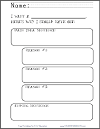Grade 6 ELA: Writing |
|---|
| www.studenthandouts.com ↣ Sixth Grade ↣ Grade 6 ELA: English Language Arts ↣ Grade 6 Writing |
Text Types and Purposes: |
|---|
CCSS.ELA-LITERACY.W.6.1: Write arguments to support claims with clear reasons and relevant evidence. |
|---|
CCSS.ELA-LITERACY.W.6.1.A: Introduce claim(s) and organize the reasons and evidence clearly. |
|---|
 |
||||||||||
| I want a... Persuasive Argument Graphic Organizer |
CCSS.ELA-LITERACY.W.6.1.B: Support claim(s) with clear reasons and relevant evidence, using credible sources and demonstrating an understanding of the topic or text. |
|---|
CCSS.ELA-LITERACY.W.6.1.C: Use words, phrases, and clauses to clarify the relationships among claim(s) and reasons. |
|---|
CCSS.ELA-LITERACY.W.6.1.D: Establish and maintain a formal style. |
|---|
CCSS.ELA-LITERACY.W.6.1.E: Provide a concluding statement or section that follows from the argument presented. |
|---|
CCSS.ELA-LITERACY.W.6.2: Write informative/explanatory texts to examine a topic and convey ideas, concepts, and information through the selection, organization, and analysis of relevant content. |
|---|
CCSS.ELA-LITERACY.W.6.2.A: Introduce a topic; organize ideas, concepts, and information, using strategies such as definition, classification, comparison/contrast, and cause/effect; include formatting (e.g., headings), graphics (e.g., charts, tables), and multimedia when useful to aiding comprehension. |
|---|
CCSS.ELA-LITERACY.W.6.2.B: Develop the topic with relevant facts, definitions, concrete details, quotations, or other information and examples. |
|---|
CCSS.ELA-LITERACY.W.6.2.C: Use appropriate transitions to clarify the relationships among ideas and concepts. |
|---|
CCSS.ELA-LITERACY.W.6.2.D: Use precise language and domain-specific vocabulary to inform about or explain the topic. |
|---|
CCSS.ELA-LITERACY.W.6.2.E: Establish and maintain a formal style. |
|---|
CCSS.ELA-LITERACY.W.6.2.F: Provide a concluding statement or section that follows from the information or explanation presented. |
|---|
CCSS.ELA-LITERACY.W.6.3: Write narratives to develop real or imagined experiences or events using effective technique, relevant descriptive details, and well-structured event sequences. |
|---|
CCSS.ELA-LITERACY.W.6.3.A: Engage and orient the reader by establishing a context and introducing a narrator and/or characters; organize an event sequence that unfolds naturally and logically. |
|---|
CCSS.ELA-LITERACY.W.6.3.B: Use narrative techniques, such as dialogue, pacing, and description, to develop experiences, events, and/or characters. |
|---|
CCSS.ELA-LITERACY.W.6.3.C: Use a variety of transition words, phrases, and clauses to convey sequence and signal shifts from one time frame or setting to another. |
|---|
CCSS.ELA-LITERACY.W.6.3.D: Use precise words and phrases, relevant descriptive details, and sensory language to convey experiences and events. |
|---|
CCSS.ELA-LITERACY.W.6.3.E: Provide a conclusion that follows from the narrated experiences or events. |
|---|
Production and Distribution of Writing: |
|---|
CCSS.ELA-LITERACY.W.6.4: Produce clear and coherent writing in which the development, organization, and style are appropriate to task, purpose, and audience. (Grade-specific expectations for writing types are defined in standards 1-3 above.) |
|---|
CCSS.ELA-LITERACY.W.6.5: With some guidance and support from peers and adults, develop and strengthen writing as needed by planning, revising, editing, rewriting, or trying a new approach. (Editing for conventions should demonstrate command of Language standards 1-3 up to and including grade 6 here.) |
|---|
CCSS.ELA-LITERACY.W.6.6: Use technology, including the Internet, to produce and publish writing as well as to interact and collaborate with others; demonstrate sufficient command of keyboarding skills to type a minimum of three pages in a single sitting. |
|---|
Research to Build and Present Knowledge: |
|---|
CCSS.ELA-LITERACY.W.6.7: Conduct short research projects to answer a question, drawing on several sources and refocusing the inquiry when appropriate. |
|---|
CCSS.ELA-LITERACY.W.6.8: Gather relevant information from multiple print and digital sources; assess the credibility of each source; and quote or paraphrase the data and conclusions of others while avoiding plagiarism and providing basic bibliographic information for sources. |
|---|
CCSS.ELA-LITERACY.W.6.9: Draw evidence from literary or informational texts to support analysis, reflection, and research. |
|---|
CCSS.ELA-LITERACY.W.6.9.A: Apply grade 6 Reading standards to literature (e.g., "compare and contrast texts in different forms or genres [e.g., stories and poems; historical novels and fantasy stories] in terms of their approaches to similar themes and topics").
|
|---|
CCSS.ELA-LITERACY.W.6.9.B: Apply grade 6 Reading standards to literary nonfiction (e.g., "Trace and evaluate the argument and specific claims in a text, distinguishing claims that are supported by reasons and evidence from claims that are not").
|
|---|
Range of Writing: |
|---|
CCSS.ELA-LITERACY.W.6.10: Write routinely over extended time frames (time for research, reflection, and revision) and shorter time frames (a single sitting or a day or two) for a range of discipline-specific tasks, purposes, and audiences. |
|---|








